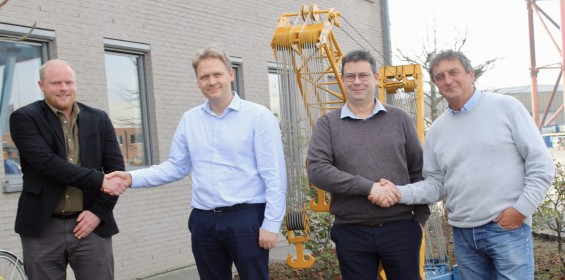Novel solution for floating offshore wind industry
Published: 29 March, 2023
OEE looks at a new partnership to deliver an innovative solution for the floating wind industry.
A partnership that will enable Tugdock Limited and Sarens, the crane rental services, heavy lifting and engineered transport company, to offer a novel solution to the fast-growing floating offshore wind industry, was recently announced.
To support the further growth of Tugdock, Sarens has invested in the startup company, which is based in Cornwall, UK. Lucas Lowe-Houghton, Director of Business Development for Tugdock, explained: “The floating offshore wind sector is expected to continue to grow rapidly. However, very few of the world’s ports have sufficient water depth and assembly quay space to build the huge turbine floaters required and conventional dry docks are not wide enough as they were originally designed for ships. Tugdock’s patented marine buoyancy bag technology solves this issue. It allows floating dry docks to be delivered by road in modular form and assembled at the port to dimensions far wider than most of the world’s existing dry docks.”
Lucas continued: “Our submersible floating dry docks can operate with as little as 5 metres draft, enabling more efficient wind turbine floater construction. The platform is then towed to deeper water for launching of the turbines. More than 8% of the total cost of a floating offshore wind farm is accounted for by assembly and installation. So, any innovation that allows this process to be carried out more efficiently and quickly will have a big impact on profitability for developers.”
Floating offshore wind turbines are located in areas where there is deeper water and higher winds than fixed wind turbine structures, enabling them to generate higher levels of power. This means they are expected to play a key role in the transition to net zero. Over 20 gigawatts of floating offshore wind power is expected to be commissioned globally by 2035, requiring over 2600 wind turbines.
Carl Sarens, Director of Technical Solutions, Projects & Engineering at Sarens, added: “Through this partnership with Tugdock, we are able to streamline the solution we offer to developers. By significantly reducing time and costs, our alliance will deliver a step change for wind turbine construction. In addition, Tugdock’s flexibility and reusability is useful to global developers as the units can be reused from one port or project to another regardless of changes in turbine size or foundation weight.”
Shane Carr, CEO of Tugdock, also explained: “Working in partnership with a large multinational such as Sarens will accelerate our development, enabling further innovation to keep us at the forefront of the floating offshore wind industry.”
Simon Cheeseman of the Offshore Renewable Energy Catapult (the UK’s leading technology innovation and research centre for offshore renewable energy) commented that Tugdock has created a “brilliant innovative solution to enhance port capacity and meet one of the most significant infrastructure challenges facing the fast-growing floating offshore wind industry.” He concluded that its partnership with Sarens will accelerate use of this solution by floating offshore wind developers across the world.
Floating offshore wind
Floating wind uses the same turbines as conventional ‘seabed-fixed’ offshore wind but they are deployed on top of floating structures that are secured to the seabed with mooring lines and anchors. Electricity is transmitted to shore via subsea cables.
This technology opens up the possibility of deploying offshore wind projects in regions with deeper waters in established markets like the UK and France, and also in new regions like Japan and the west coast of the USA.
A report by the Global Wind Energy Council stated: “Interest in floating offshore wind is growing rapidly. A number of early pioneer markets in western Europe and Southeast Asia are leading the way, with policy in place or in finalization to support this rapid growth. This rapid growth in ambition points strongly to the emergence of floating offshore wind as a technology ready for deployment at scale.
“By 2026 we expect annual installations to surpass 1GW per year, a milestone that fixed offshore wind reached in 2010. From this point forward, floating offshore wind will be in its commercial phase. Installation rates will continue to increase and project size will grow, contributing to rapid cost reduction.
“Full commercialisation is expected to be achieved toward the end of this decade with the first multi-GW level large scale floating projects connected in both Europe and East Asia. These strong projections can be justified given the volume of known project activity and extent of leasing rounds underway in countries like France, Japan, South Korea and the UK.”
https://twitter.com/tugdocklimited
https://www.linkedin.com/company/tugdock-limited/
https://www.linkedin.com/company/sarens/

From left to right: Lucas Lowe-Houghton (Tugdock); Wim Sarens (Sarens); Carl Sarens (Sarens); Shane Carr (Tugdock)





